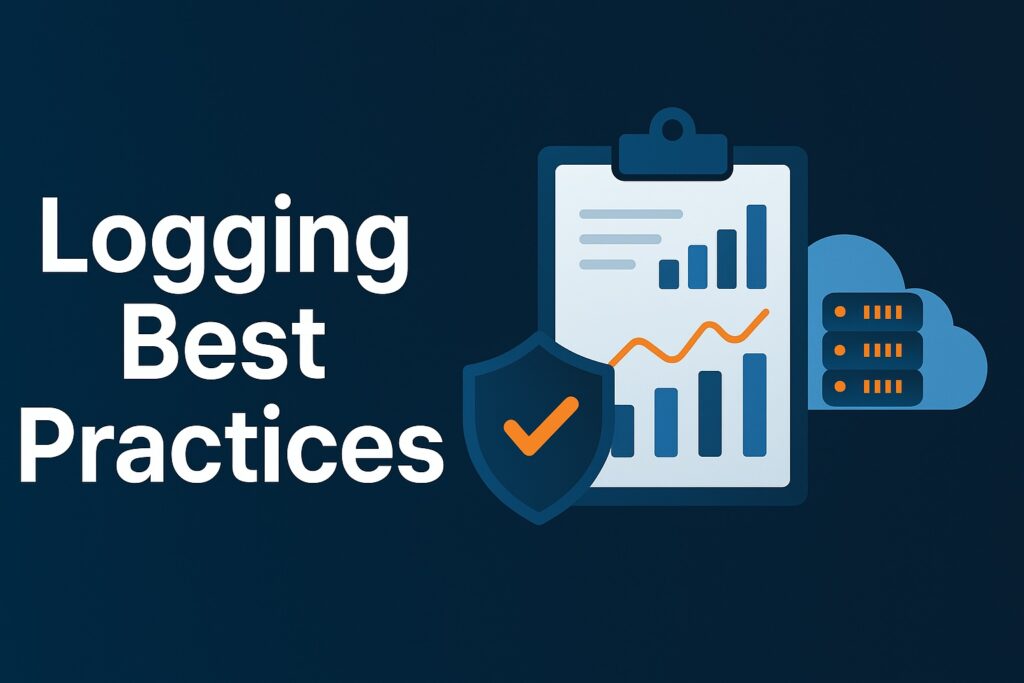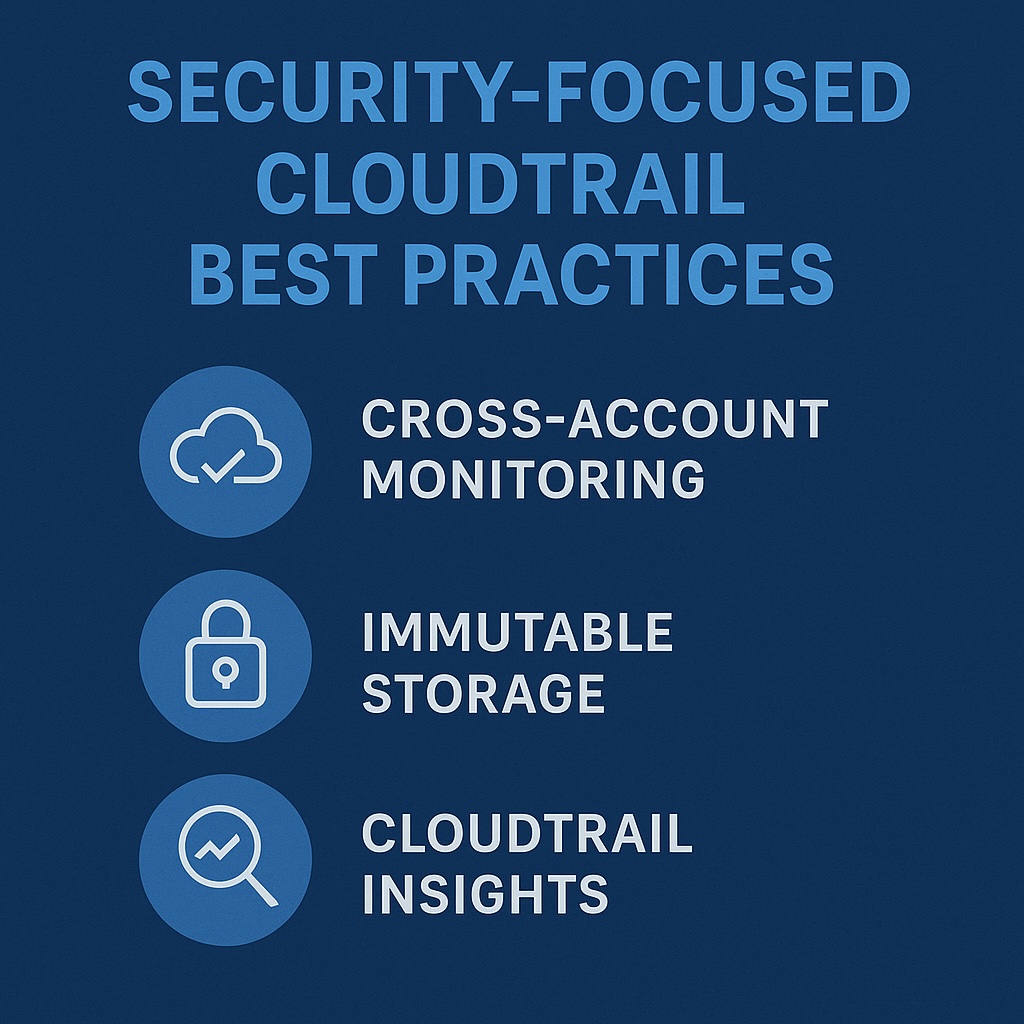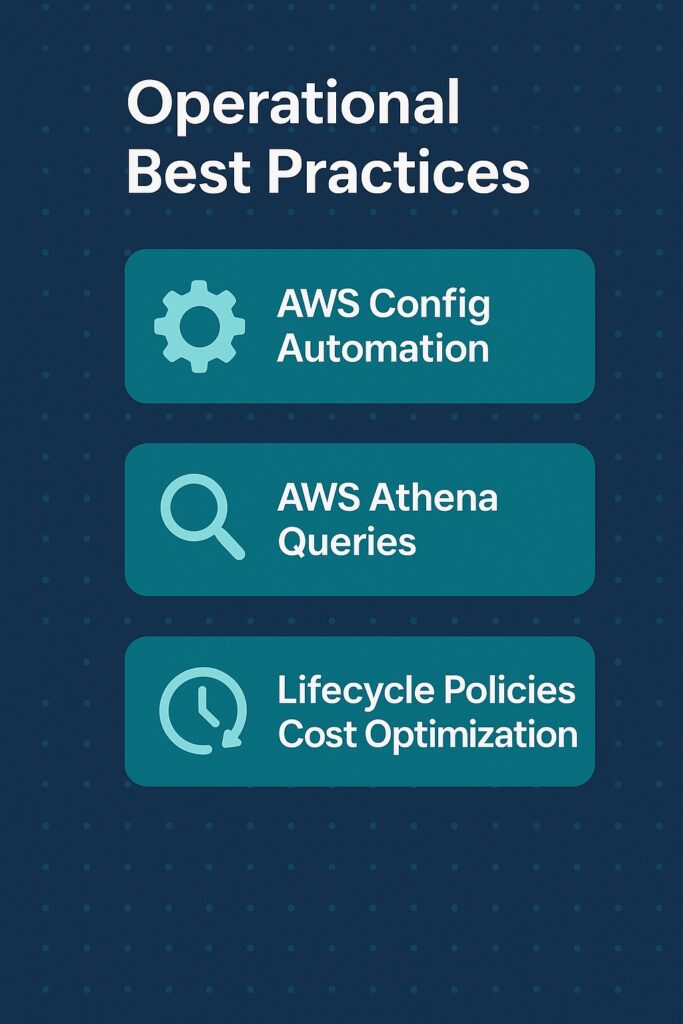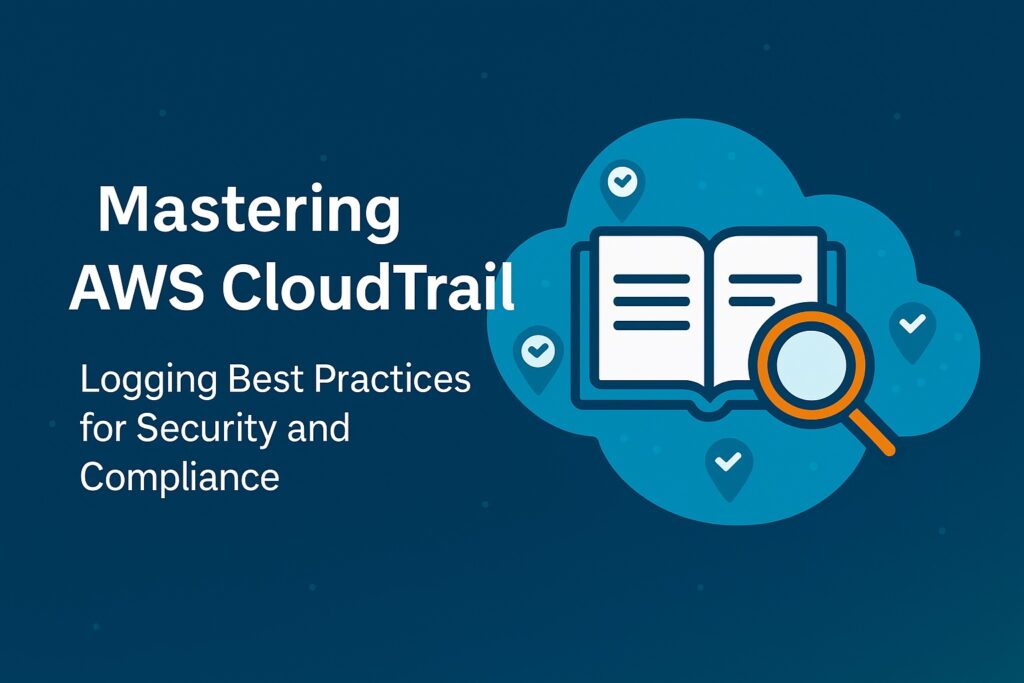AWS CloudTrail Logging Best Practices – Introduction
Logging AWS CloudTrail events is critical for AWS cloud security and compliance, making best practices essential for secure networks.
AWS CloudTrail is a logging service that records all API invocations across all accounts of an organization. Therefore, it helps organizations to strengthen their IT security by detecting unauthorized access and unusual activity. Organizations also benefit from having a detailed audit trail of who did what, when, and from where in the environment. This is especially crucial for investigations whenever an incident does occur because they are tamper-resistant. Additionally, they are highly valuable for security audits. Therefore, they provide organizations with proactive monitoring and efficient incident response.
Best practices are vital since they ensure CloudTrail logging is complete and reliable across all AWS regions. Crucially, they provide the protection of sensitive log data from tampering or unauthorized access. Additionally, following best practices ensures compliance audits are smoother and more accurate. Furthermore, they allow faster detection of anomalies, threats, and suspicious activities. Implementing well-managed logging will help to reduce blind spots while strengthening overall cloud security posture. Another key consideration is that best practices help to optimize the log storage and monitoring costs without compromising security.
Why AWS CloudTrail Matters for Security and Compliance
There are several significant areas where best practices for logging AWS CloudTrail are vital.
AWS CloudTrail best practices are crucial for AWS Cloud governance. They enforce the recording of every API call across AWS accounts for accountability. Therefore, an organization has transparent activity logs that support both corporate and regulatory governance standards. Furthermore, governance teams can use CloudTrail logs to validate and audit security controls and enforce policies. Many organizations have multi-account AWS environments where centralizing CloudTrail logging is a best practice that ensures consistent oversight across the whole organization.
Preventative measures are essential, but do not guarantee that incidents will never occur. Therefore, performing forensics on incidents is an integral component of an organization’s security posture. Specifically, AWS CloudTrail logs provide investigators with a timeline of all API activity during an incident, which is a key best practice. Specifically, they help investigators identify the source of unauthorized access and compromised credentials. Additionally, forensic teams can use CloudTrail to trace attacker movements across AWS resources to get a full picture of an attack. Furthermore, these logs show exactly which actions triggered failure or breaches, which support root cause analysis.
Compliance reporting is integral to satisfying corporate and regulatory compliance, and CloudTrail logs are a vital part of this. Specifically, CloudTrail logs contained detailed activities that match regulatory reporting requirements. These logs enable auditors to verify that an organization has consistently applied security controls across all its AWS accounts. Also, by automating log retention policies, organizations have long-term evidence storage for compliance audits. They also help simplify demonstrating compliance with standards like PCI DSS, HIPAA, and GDPR.
AWS CloudTrail Best Practices for Logging
We will now consider the main general best practices for CloudTrail logging.
All Regions Enabled
It is highly recommended to enable CloudTrail logging in all regions to ensure complete visibility across the AWS environment. Specifically, regions not actively used are potential blind spots that CloudTrail logging addresses. Accordingly, attackers often target unused regions; therefore, logging everywhere reduces this risk. Furthermore, CloudTrail will automatically include new AWS regions whenever all-region logging is enabled. Additionally, all-region logging supports compliance by guaranteeing global coverage of audit trails.
Multi-trail setup
Setting up multiple trails is an essential AWS CloudTrail logging best practice, where security-focused logs are kept separate from operational logs. Furthermore, this enables fine-grained monitoring for different teams or business units. Additionally, setting up multi-trail supports compliance by isolating sensitive audit data from general activity logs. Another key benefit is that separate trails reduce noise, making it easier to detect anomalies and threats. Also, this practice enables the tailoring of log retention and storage policies per use case.
S3 bucket + access control
Safe and cost-efficient storage of AWS CloudTrail logs is a crucial best practice, and S3 is an ideal service for this purpose. Foremost, storing CloudTrail logs in a dedicated S3 bucket will centralize management of these logs. Least-privilege IAM policies are a fundamental best practice for restricting access to log data. Preventing public access to these logs is also fundamental through bucket policies and ACLs. Additionally, encryption at rest is essential by enabling server-side encryption. Furthermore, we should also track who interacts with CloudTrail logs by enabling access logging on the S3 bucket.
KMS encryption
Since we should perform server-side encryption, it follows that we should use AWS KMS to perform this encryption. This is because KMS integration provides centralized key management and rotation, further enhancing log security. Furthermore, an organization can use customer-managed keys to gain full control over access to the CloudTrail logs. Additionally, using KMS allows granular policies to fine-tune permissions over who can decrypt log files. Therefore, by using KMS, we can strengthen compliance by meeting encryption requirements in security standards.
Log file validation
Preventing alteration and tampering with AWS CloudTrail logs is a vital best practice, which is supported by validating log files. This will also strengthen trust in audit data during investigations or reviews. Additionally, this will assist with detecting any accidental corruption or malicious modifications to log files. Furthermore, this will support regulatory requirements for data authenticity and non-repudiation.
CloudWatch integration
While S3 provides secure storage and offline analysis, publishing CloudTrail logs to CloudWatch enables real-time monitoring of AWS activity. We can set up CloudWatch Alarms to automatically alert security teams to suspicious events. Additionally, we can track API usage patterns and anomalies through custom metrics with CloudWatch. Furthermore, setting up CloudWatch dashboards provides visual insights into trends across multiple AWS accounts. Also, linking CloudTrail with CloudWatch supports automated incident response workflows.

Security-Focused CloudTrail Best Practices
Alongside best practice for AWS CloudTrail logging, we have those focused on security.
Cross-Account Monitoring
Many organizations establish multiple AWS account environments that potentially give rise to blind spots, providing opportunities for attackers. Therefore, a key AWS CloudTrail best practice is to set up cross-account monitoring. This enables centralized visibility of CloudTrail logs across all AWS accounts, thereby strengthening security by preventing blind spots. Subsequently, aggregating logs in a central account reduces the risk of individual accounts disabling or altering logging. It also supports governance by enforcing consistent security policies across the organization. Additionally, centralized monitoring enhances incident response by facilitating the faster correlation of security events. By maintaining a unified audit trail across all accounts, organizations can better ensure compliance.
Immutable Storage
Another essential AWS CloudTrail best practice is guaranteeing that CloudTrail logs can never be altered or tampered with. Immutable storage systems are crucial for ensuring that CloudTrail logs are never altered or deleted after they are written. Therefore, organizations can use S3 Object Lock, which provides write-once, read-many (WORM) protection for log files. Additionally, Glacier Vault Lock is available, which enforces compliance-driven retention policies for long-term AWS CloudTrail logs. Furthermore, immutable storage is crucial for strengthening forensic investigations by preserving original evidence. Subsequently, this helps organizations meet regulatory requirements for data integrity and retention. Overall, immutable storage supports audit readiness by ensuring that logs remain authentic and tamper-proof.
CloudTrail Insights
Using AWS CloudTrail Insights is a primary best practice that defines a key goal of CloudTrail logging. It automatically detects unusual activity within organizations’ AWS environments. Specifically, they help to identify sudden spikes in resource provisioning that may signal malicious activity. Additionally, they can uncover unusual permission changes that point to compromised credentials. Significantly, this best practice reduces noise by focusing solely on anomalies rather than normal API calls. Therefore, security teams can use Insights to prioritize investigations based on abnormal patterns. Furthermore, they can also integrate Insights with CloudWatch to enable real-time alerts for suspicious events.

Operational Best Practices for AWS CloudTrail
AWS CloudTrail operational best practices perfectly complement both logging and security as the third part of the trifecta.
AWS Config Automation
Complementing AWS CloudTrail with AWS Config automation is a valuable best practice that organizations can apply. Specifically, AWS Config can automatically track changes to AWS resources alongside CloudTrail activity logs. Therefore, it provides continuous compliance monitoring by checking configurations against policies. This helps to remediate misconfigurations without manual intervention. Config rules are essential for AWS Cloud Trail since they can detect when CloudTrail is disabled or misconfigured in an AWS account. Subsequently, integrating AWS Config with AWS CloudTrail can ensure that resource changes are associated with specific API activity. This further simplifies audits by aligning operational changes with CloudTrail event history, reducing human error and strengthening operational efficiency.
AWS Athena Queries
This is a compelling best practice for AWS CloudTrail by allowing querying of logs directly in S3 without loading them into a database. Specifically, organizations have fast, serverless log analysis using standard SQL syntax. Through Athena queries, they can identify trends in API usage across accounts and regions. Additionally, they can use queries to filter and isolate suspicious and unauthorized activities. An added benefit is Athena’s integration with QuickSight, enabling organizations to create dashboards for CloudTrail analytics. Thereby, organizations can avoid complex ETL pipelines through this approach. Ultimately, organizations can improve cost efficiency by using Athena, as they only pay for the data scanned.
For a deeper dive into how AWS services streamline machine learning workflows, see our guide on Mastering SageMaker Training Jobs.
Lifecycle Policies / Cost Optimization for AWS CloudTrail Best Practices
Examining life cycle policies and cost optimization rounds out exploring AWS CloudTrail operational best practices. Lifecycle policies are necessary for cost management since they automatically transition CloudTrail logs to lower-cost storage classes. Additionally, moving older logs to S3 Glacier helps to reduce long-term storage expenses. Also, they can delete outdated logs that are no longer needed once retention requirements are met. Therefore, it is a significant best practice because it balances compliance needs with cost efficiency.
Automated storage management also reduces manual overhead for operational teams while preventing unnecessary accumulation of stale CloudTrail data. This makes CloudTrail logging sustainable at scale.

Common Pitfalls to Avoid
Besides best practices, there are several common pitfalls associated with AWS CloudTrail logging.
Whenever organizations rely on default trail limits, they limit visibility to a single region, resulting in blind spots. It is easy to forget that default trail limits do not automatically capture activity across all AWS regions. Subsequently, there is an increased risk of missing unauthorized activity in regions that are not actively used. Furthermore, organizations may fail compliance requirements when they depend solely on the default trail.
Validating logs is clearly a best practice for AWS CloudTrails; therefore, not having validation is dangerous, and organizations cannot validate their integrity. Additionally, this makes forensic investigation far less reliable due to possible tampering or corruption. This may lead to auditors rejecting these logs because they lack cryptographic proof of authenticity. Furthermore, failing to enable log validation will weaken compliance with data integrity standards. Overall, trust in CloudTrail as a source of truth for security events is compromised.
Over-permissive S3 bucket policies are one pitfall that organizations want to avoid since they expose AWS CloudTrail logs to unauthorized users. Public access to these logs certainly increases the risk of data leakage or tampering. Therefore, such weak controls undermine the confidentiality of sensitive audit data. Moreover, excessive permissions could potentially violate compliance and governance requirements. Hence, best practices are to enforce least-privilege IAM policies for AWS CloudTrail log buckets.

Conclusion: Strengthening Security with AWS CloudTrail Best Practices
AWS CloudTrail is an essential component in the cloud computing security armoury that strengthens security, compliance, and operational visibility. Hence, applying best practices ensures complete, reliable, and tamper-resistant logging across all accounts and regions. Additionally, security-focused measures such as cross-account monitoring, immutable storage, and Insights enhance detection and response capabilities. Also, implementing operational best practices such as Config automation, Athena queries, and lifecycle policies makes AWS CloudTrail sustainable at scale. It is essential to avoid common pitfalls to maximize CloudTrail’s value as a trusted foundation for cloud governance and security.
AWS CloudTrail best practices not only enhance cloud security but also simplify audits and regulatory reporting. Therefore, a well-implemented CloudTrail strategy builds resilience by aligning security, compliance, and cost efficiency.
Start applying these AWS CloudTrail best practices today to strengthen your cloud security and ensure your organization stays audit-ready.
Further Reading
AWS Certified Security – Specialty Exam Guide (by Stuart Scott)
Practical Cloud Security: A Guide for Secure Design and Deployment (by Chris Dotson)
AWS Security Cookbook (by Heartin Kanikathottu)
Affiliate Disclosure: As an Amazon Associate, I earn from qualifying purchases. This means that if you click on one of the Amazon links and make a purchase, I may receive a small commission at no additional cost to you. This helps support the site and allows me to continue creating valuable content.


